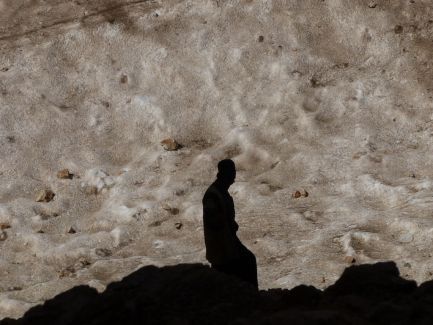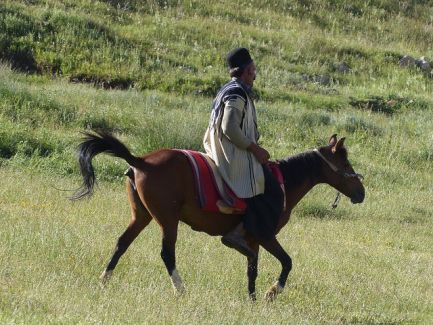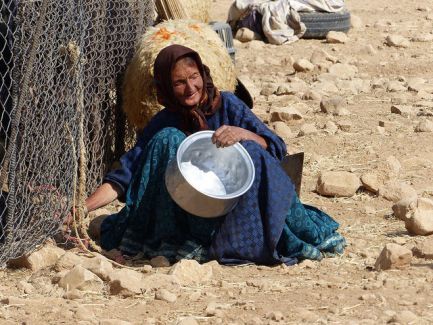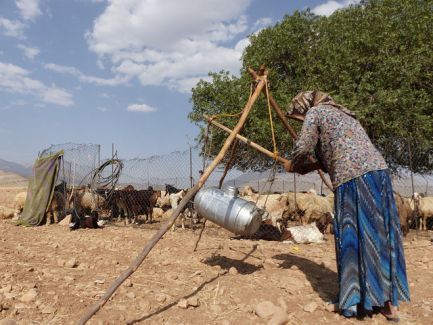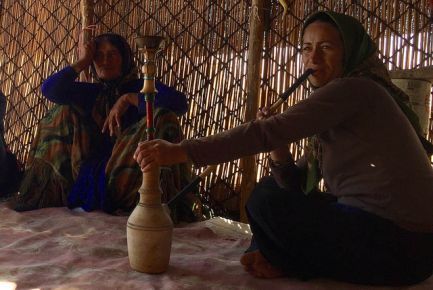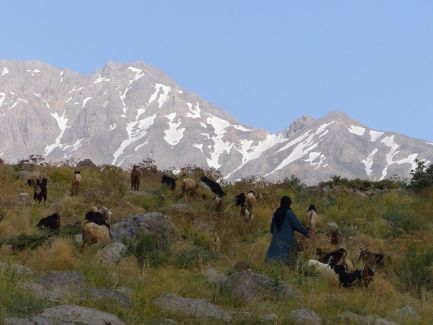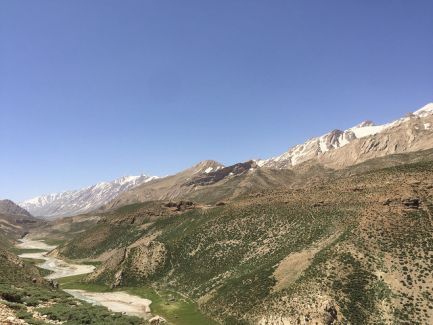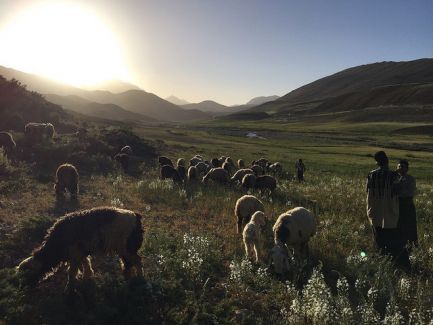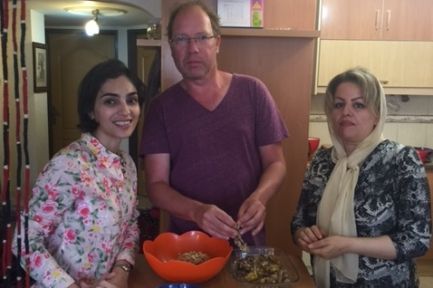In the footsteps of Iranian Nomads
Follow the ancient routes of the Bakhtiari and Ghasgai Nomads in Iran
The Nomad Trail, Iran
In the footprints of Nomads
Completely exhausted I’m standing on a glacier somewhere in Koohrang, in the Zagros Mountains in Iran. After a heavy climb and a very steep downhill, more sliding than walking, I am standing on what Jahangir called an always snow-covered spring. Jahangir is laughing and looks compassionate to my clambering. It looks like he just hops on and off the mountain. He will never choose the easy way around, he just goes straight, steep or not steep, path or no path. It’s clear that Jahangir is an Bakhtiari, one of the nomadic tribes of Iran. Although by travellers Iran is famous for its Islamic architecture, the remains of the Persian Empire and the desert towns, this country is also a country with one of the largest nomadic populations in the world. The best-known nomadic tribes are the Ghasga’i, the Bakhtiari, the Kurds, the Shahsavan, the Turkomanen, the Baluchis and the Talesh. Almost 20 years ago I made an adventurous tour visiting these tribes, still one of the best trips I’ve ever made. In the most beautiful and wildest landscapes I was warmly welcomed everywhere by very traditional living nomads. I wonder if their culture still exists and I return to the mountains of Iran seeking the Ghasga’i and Bakthiari.
Completely exhausted I’m standing on a glacier somewhere in Koohrang, in the Zagros Mountains in Iran. After a heavy climb and a very steep downhill, more sliding than walking, I am standing on what Jahangir called an always snow-covered spring. Jahangir is laughing and looks compassionate to my clambering. It looks like he just hops on and off the mountain. He will never choose the easy way around, he just goes straight, steep or not steep, path or no path. It’s clear that Jahangir is an Bakhtiari, one of the nomadic tribes of Iran. Although by travellers Iran is famous for its Islamic architecture, the remains of the Persian Empire and the desert towns, this country is also a country with one of the largest nomadic populations in the world. The best-known nomadic tribes are the Ghasga’i, the Bakhtiari, the Kurds, the Shahsavan, the Turkomanen, the Baluchis and the Talesh. Almost 20 years ago I made an adventurous tour visiting these tribes, still one of the best trips I’ve ever made. In the most beautiful and wildest landscapes I was warmly welcomed everywhere by very traditional living nomads. I wonder if their culture still exists and I return to the mountains of Iran seeking the Ghasga’i and Bakthiari.
Across the glacier
Still moaning and puffing I look up to the glacier that rises nearly straight up a mountain of
4,000 meters, fascinating to see and impossible to climb, I think. Jahangir
smiles: ‘through this mountain we hike every year to our winter home in
Khuzestan’. That absolutely blows my mind: women, children, sheep, goats and of
course the men, all of them climbing over the steep mountain. Behind the
mountain, moreover, is another one. Despite the modernization which certainly
takes place here, every year the family walks hundreds of kilometers from their
winter home in Khuzestan to the summer home in the mountains of Chahar-e
Mahal-e Bakhtiari, scenically the most beautiful region of Iran. And in the
fall they walk back again. Where many nomads now take a pickup truck for this
biannual trek, for many of the Bakhtiai this is still the way of their
ancestors, by foot, mountain to mountain.
Looking for the Ghasga’i nomads
I started my tour in the city of poets: Shiraz. In the alleyways of the bazaar you’ll see the
occasional colourful woman walking around in waving multi-coloured skirts.
Especially in Iran, where there are still many women in a black chador (apart
from the hipper, younger generation who replaced the headscarf by fashionable
scarfs), these women are a striking appearance. They belong to the Ghasga’I
tribe, the largest nomadic tribe in Iran. There are approximately two million
Ghasga’I, from which only 20,000 still live as nomads in tents in the mountains
of Fars. Tha Ghasga’I annually hikes back and forth between their winter homes
in the southern regions of Fars and the summer homes in the higher parts of the
Zagros mountains. Almost twenty years
ago I saw them walk with their herds along the way, fascinating to see,
sometimes even 600 kilometers were travelled by foot, a journey that could last
for weeks. Most Ghasga'I nowadays do it in a day, by a pick-up truck. This
makes sense, why not make use of modern developments. Also, most families have
a house in a village or town, where especially the younger generation grows up.
Fortunately, there are many Ghasga'i who live in the traditional way in the
mountains and I hope to visit some of those families. That's not as easy as it
sounds, the mountains are huge, the nomads often live in isolated valleys, far
from the road and varies from year to year when they travel from their winter
to summer residence and vice versa, depending on the weather. Normally the trek
takes place in May and September, but some families leave a month earlier and /
or stay a month longer.
Firuzabad
The first day I drive towards the surroundings of Firuzabad. Now, however, in early June, most
Ghasga'i families already left to the higher valleys. But I was warmly welcomed
by the family of Bahadoni Zadegan, who still stored
their characteristic black tent of goat hair in the winter home. Here they live,
in very basic conditions, with grandfather, grandmother and three children and
their herd of goats and sheep. In a few weeks they hope to leave. The family is
most friendly and introduces me to all aspects of their existence. Together
with the lady of the house, I can milk the sheep and make dough (a yogurt drink
that is made the traditional way by a homemade bag of sheep skin; or a (modern)
milk churn, hanged up on a tripod made of wood and shaked back and forth. Meanwhile grandma is spinning
wool, dad is taking the sheep inside and grandfather pushes his shotgun in my
hands. After all, the mountains are full of wolves, jackals and bears.
Ghasga’I making poetry
The next day I drive by the upper sections of the Zagros Mountains. Together with Bahman I
visit his family who live in a remote valley. There are four tents together in
this valley, where (of course) a small river flows through. The Ghasga'i all
live quite spread apart from each other, usually two to four tents together,
all family. Bahman begins to sing spontaneously and declaring self-written
poems about the nomadic life, the translation goes something like this:
"As the water flows from the tap and you drink as much as you want,
think of my mother how long she have to walk for a bucket of water.
If you are sleeping in bed, quietly in a long night,
think of my father, who sleeps with one eye closed and one eye on the sheep. "
A typical poem of this modern Ghashga’I, who lives in the city, but only comes to life when he is in the mountains with his family. For breakfast I get kaljoosh, a boiled yoghurt drink with bread and butter. I'm here with some friends from Tehran, modern Iranians, who are completely shocked when it is announced that they will kill a chicken for us. After much protest and uncomprehending glances they decide not the kill the chicken. They scream at the neighbours, who then decide to kill a sheep instead. My friends dispiritedly crawl away in a corner of the tent. I'll just see how skilfully the sheep is slaughtered and how each part of the animal is used for something.
"As the water flows from the tap and you drink as much as you want,
think of my mother how long she have to walk for a bucket of water.
If you are sleeping in bed, quietly in a long night,
think of my father, who sleeps with one eye closed and one eye on the sheep. "
A typical poem of this modern Ghashga’I, who lives in the city, but only comes to life when he is in the mountains with his family. For breakfast I get kaljoosh, a boiled yoghurt drink with bread and butter. I'm here with some friends from Tehran, modern Iranians, who are completely shocked when it is announced that they will kill a chicken for us. After much protest and uncomprehending glances they decide not the kill the chicken. They scream at the neighbours, who then decide to kill a sheep instead. My friends dispiritedly crawl away in a corner of the tent. I'll just see how skilfully the sheep is slaughtered and how each part of the animal is used for something.
Dena nature sanctuary
Through a beautiful road, green valleys, gushing mountain streams and still snow here and there, we drive towards Yasauj.
Through a beautiful road, green valleys, gushing mountain streams and
here and there still snow on the mountains we drive towards Yasuj. Along the
way we see some Ghasga'i families and we are invited for a cup of tea at the
Morad family. They live in the valley with the poetic name "the valley
of the lonely walnut tree ".
Once in the busy city of Yasuj we decide to drive a little firther to Sisakht, a hilltop town at the foot of Mt. Dena, one of the highest peaks of Iran (4409 meters high). The town itself is not much, but the nature sanctuary of Dena is increadibly beautiful, a paradise for hikers. And of course some Ghashga’I who have their summer home here.
Once in the busy city of Yasuj we decide to drive a little firther to Sisakht, a hilltop town at the foot of Mt. Dena, one of the highest peaks of Iran (4409 meters high). The town itself is not much, but the nature sanctuary of Dena is increadibly beautiful, a paradise for hikers. And of course some Ghashga’I who have their summer home here.
A visit to the Bakhtiari
The next day we slowely change from the living area of Ghashga’I to the living are of the Bakhtiari. A wonderful tour takes us via
Semirom to Koohrang. The surrounding of Semirom is gorgeous, expansive valleys
with snow-covered mountains in the distance. Here and there the familiar black
tents of the Ghasga'i, of course, they are drinking a lot of tea.
Through Bojunerd and Boldaji, we arrive at the lake of Chogsakor. Here we see the first Bakhtiari, they they just arrived and all their belongings are lying in the grass. The tents are built and we exchange some information. In the valley behind the Chogsakor lake are more Bakhtiari. They are already a few weeks here. Grandpa grumbles something on his grandchildren who have no sense for herding sheep and goats. By the way, not just regular sheep, it is a fierce-looking sheep, big, huge horns, lots of wool, and heaps of fat hanging from their ass. Exactly the part that makes the Baktiari kebab so tasty.
While we are getting higher, the landscape is becoming rougher an more beautiful. Especially with the nice, soft, warm light at the end of the day. A clear blue sky, snow-capped mountains, green valleys, more Bakhtiari tents with their herds, truly a paradise.
We spend the night in a tent camp that has been put down by an entrepreneurial Bakhtiari at the place that belongs to his family for decades. Anyhow, the country in this entire region belongs to the Bakhtiari, who received this contractually by the last shah. Here we meet Jahangir, a very friendly man who introduces us everywhere. He talks about his two children and his wife who is pregnant. Because she could give birth any moment, she lives temporarily in a distant village. Doesn’t he miss her, I ask. Of course not, I'm still a man answered Jahangir.
Jahangir shows us around, we talk about the issues that the Bakhtiari talk about, especially about the wellbeing of sheep, we ride through valleys whit dozens of tents and 'just walk to a spring that is always covered with snow‘.
Oh, and once we were down at the glacier, we did not have to climb back up, we would go down through the glacier and a piece of the river. That seemed like a good plan, until Jahangir, once arrived at the glacier, casually mentioned that the icy water in the river was one and a half meters high and was flowing quite fierce. So we had to climb back up, with deep respect for the Bakhtiari which annually tame the many impressive mountain passes. If we want to walk along next year, Jahangir asks. Yes please!!
We had a fabulous time in this alpine environment, a paradise for hikers, horseback riders, the nomadic culture lovers and anyone who wants to see more of Iran than the cities, however beautiful they may be.
Through Bojunerd and Boldaji, we arrive at the lake of Chogsakor. Here we see the first Bakhtiari, they they just arrived and all their belongings are lying in the grass. The tents are built and we exchange some information. In the valley behind the Chogsakor lake are more Bakhtiari. They are already a few weeks here. Grandpa grumbles something on his grandchildren who have no sense for herding sheep and goats. By the way, not just regular sheep, it is a fierce-looking sheep, big, huge horns, lots of wool, and heaps of fat hanging from their ass. Exactly the part that makes the Baktiari kebab so tasty.
While we are getting higher, the landscape is becoming rougher an more beautiful. Especially with the nice, soft, warm light at the end of the day. A clear blue sky, snow-capped mountains, green valleys, more Bakhtiari tents with their herds, truly a paradise.
We spend the night in a tent camp that has been put down by an entrepreneurial Bakhtiari at the place that belongs to his family for decades. Anyhow, the country in this entire region belongs to the Bakhtiari, who received this contractually by the last shah. Here we meet Jahangir, a very friendly man who introduces us everywhere. He talks about his two children and his wife who is pregnant. Because she could give birth any moment, she lives temporarily in a distant village. Doesn’t he miss her, I ask. Of course not, I'm still a man answered Jahangir.
Jahangir shows us around, we talk about the issues that the Bakhtiari talk about, especially about the wellbeing of sheep, we ride through valleys whit dozens of tents and 'just walk to a spring that is always covered with snow‘.
Oh, and once we were down at the glacier, we did not have to climb back up, we would go down through the glacier and a piece of the river. That seemed like a good plan, until Jahangir, once arrived at the glacier, casually mentioned that the icy water in the river was one and a half meters high and was flowing quite fierce. So we had to climb back up, with deep respect for the Bakhtiari which annually tame the many impressive mountain passes. If we want to walk along next year, Jahangir asks. Yes please!!
We had a fabulous time in this alpine environment, a paradise for hikers, horseback riders, the nomadic culture lovers and anyone who wants to see more of Iran than the cities, however beautiful they may be.
Isfahan
This beautiful mountainous area is only a few hours drive from the famous city of Iran; Isfahan. Here I will finish my trip. Ramadan has begun, I
didn’t noticed that before in the mountains between the nomads. Here in Isfahan
it is difficult to eat by day (except your room), but because of that, at night
the city is even more alive. The famous Meidum-Emam Square, the tourist
attraction of the city with its surrounding bazaar, mosques and palaces, is becoming
very busy with families who picnic. Around 20:30 when the muezzin announcing
the fitar, the whole square comes alive and until way after midnight the square,
and in many other parks in the city, is very charming and cozy. Also in the Armenian
quarter Jolfa, which has developed into one of the best entertainment areas of
Iran, with its many restaurants and trendy coffee shops full of students.
Meet a local in Isfahan
I drive to one of the suburbs of Isfahan, a city that is increasingly growing. Here are modern apartments, against a background
of bare, dry mountains. A district of the city where the average tourist never
comes. In first place logical, with all the stunning beauty Isfahan has to offer.
But right here you can see how a big part of the population really live. And here
I meet Mahnaz, a friendly lady who loves to cook and share here knowledge. She
moved here from the city on purpose, she used to live in the city center. But it was getting busier, so she moved with
her husband and two daughters to this quiet neighborhood. She likes to cook
togherter with foreigners or only eat if they do not want to cook. I chose the
cook together. I’d also like to shop for the ingredients together, but it’s Friday
and the shops are closed.
I am warmly welcomed with a delicious glass of sharbat, a refreshing cucumber drink. And then we get started. We make two traditional Iranian dishes, which you almost never can order in a restaurant. First tahchin, a type of cake of rice with saffron and chicken, than kashk-e bademjoun, a delicious creamy eggplant dish. Meanwhile we are chatting about life in Iran and The Netherlands. We enjoy a lavish and delicious lunch (even during Ramadan!), talk about her desire to move to America to give her daughters a new future. After a few hours it is time to say goodbye.
Wim van Ginkel, Isfahan, 2016
I am warmly welcomed with a delicious glass of sharbat, a refreshing cucumber drink. And then we get started. We make two traditional Iranian dishes, which you almost never can order in a restaurant. First tahchin, a type of cake of rice with saffron and chicken, than kashk-e bademjoun, a delicious creamy eggplant dish. Meanwhile we are chatting about life in Iran and The Netherlands. We enjoy a lavish and delicious lunch (even during Ramadan!), talk about her desire to move to America to give her daughters a new future. After a few hours it is time to say goodbye.
Wim van Ginkel, Isfahan, 2016

